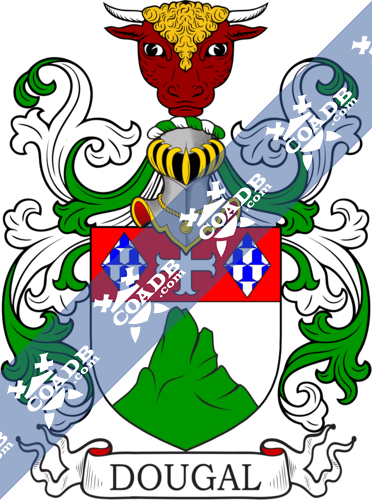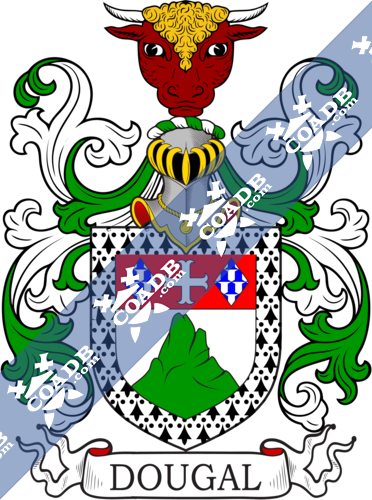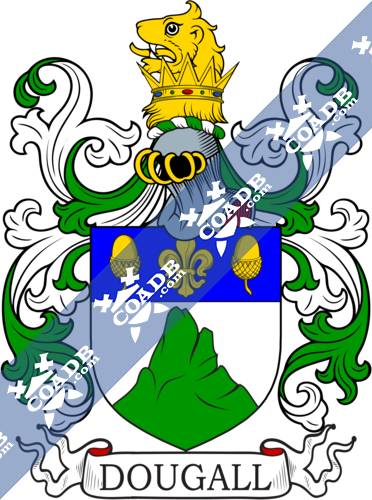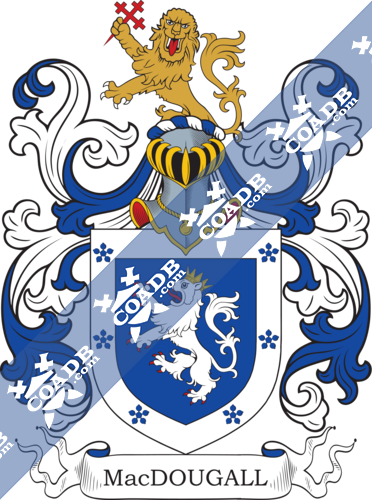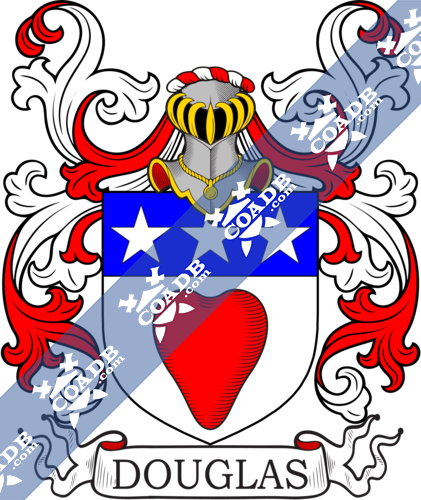Dougal Family Crest, Coat of Arms and Name History

Dougal Coat of Arms Gallery
Don’t know which Coat of Arms is yours?
We can do a genealogical research. Find out the exact history of your family!
Learn MoreDougal Origin:
Scotland, Ireland
Origins of Dougal:
This is an unusual surname of Scottish and Irish origin and was acquired from the Gaelic name Dubhgall, the combination of the components “dubh” which means “black” and “gall,” which means “stranger”. It was used as a byname for Scandinavians, in special to recognize the dark-haired Danes from fair-haired Norwegians. The name now mainly appears in the district of Ulster and in Scotland where it is wide-spread. With the prefix “Mac” which means “son of,” the name becomes Macdougal, MacDoual, etc. The surname records back to the early 12th Century. Differences in the phrase of the spelling such as Dougal, Dougill, Dugall, Dugald, Dowall, Doyle, etc.. One Elizabeth, daughter of William Dowgill, named in June 1577, and his son William named in September 1583, both at St. Mary le Bow, London. June, daughter of Peter Dougall, named at St. Luke’s, Chelsea in January 1745.
Variations:
More common variations are: Dougall, Dougale, Dougala, Diougal, Dugal, Dogal, Dougally, Dougallo, Dougale
Scotland:
The surname Dougal first appeared in Galloway, an area of southwestern Scotland, now part of the Cabinet Area of Dumfries and Galloway, that previously consisted of the divisions of Wigtown (West Galloway) and Kirkcudbright (East Galloway), where they defeated from Dugall eldest son of Somerled, first king of the Islands, and his son Duncan who got the lands of Lorn. The Tribe was an angry enemy of Robert the Bruce, who made a narrow escape during one battle with the MacDougals only by dropping his cloak. The clasp of this cloak, now known as the Brooch of Lorn, is a treasured property of the Head of the Tribe. The Family faced heavy punishment and displaced from their lands once Robert the Bruce defended the Scottish throne. The lands returned to the Tribe upon the death of the king, but passed to the Stewarts in 1388 when the last part of the main branch of MacDougals passed away without issue. The very first recorded spelling of the family was shown to be that of Dufgal filius Moccche, dated about 1128, in the “St. Serf’s Island in Loch Leven”. It was during the time of King David I of Scotland, dated 1124 – 1153.
Ireland:
Many of the people with surname Dougal had moved to Ireland during the 17th century.
United States of America:
Individuals with the surname Dougal landed in the United States in two different centuries respectively in the 18th and 19th. Some of the people with the name Dougal who arrived in the United States in the 17th century included James Dougal landed in New York in 1774. Walter Dougal also arrived in New York, NY in the same year 1774. The following century saw more Dougal surnames arrive. Some of the people with the name Dougal who arrived in the United States in the 19th century included Sarah Dougal at the age of 20, arrived in New York, NY in 1804. John Dougal, who arrived in New York in 1833.
Canada:
Some of the people with the surname Dougal who came to Canada in the 18th century included Mr. Anthony Dougherty U.E. who settled in Canada near the year 1784.
Australia:
Some of the individuals with the surname Dougal who landed in Australia in the 19th century included Catherine Dougal arrived in Adelaide, Australia aboard the ship “Lysander” in 1839. Janet Dougal arrived in South Australia in 1855 aboard the ship “Grand Trianon.” Here is the population distribution of the last name Dougal: United States 724; England 640; Scotland 269; Belize 112; Northern Ireland 107; Australia 71; France 49; Canada 41; New Zealand 40; Ireland 22.
Notable People:
Jimmy Dougal (October 1913 –October 1999) was a Scottish football player, who played as an inside forward for Kilsyth Rangers, Falkirk, Preston North End, Carlisle United, Halifax Town and Chorley.
Blazons & Genealogy Notes
1) (Scotland). Ar. a mountain vert. Crest—A bull’s head cabossed ppr.
2) (Glenferness, co. Nairn). Motto—Stand fast. Ar. a mountain vert, on a chief gu. a cross moline of the field betw. two lozenges vair. Crest—A bull’s head cabossed ppr.
3) (Calcutta, 1842). (Glenferness; registered to Lieut.-Col. Richard Roney, Adjutant at Jersey, on his assuming by royal licence, 12 June, 1871, the surname and arms of Dougal, known as “Dougal of Ratho”). Same Arms, within a bordure erm. Same Crest and Motto.
4) (Scotscraig, co. Fife). Motto—Above the Crest: Auxilio Dei; below the shield: Stand fast. Ar. a mountain vert on a chief az. a fleur-de-lis betw. two acorns or. Crest—A lion’s head erased ppr. gorged with an antique crown or.
5) (Makerston, co. Roxburgh; Ann Maria Hay Makdougal, eldest dau. and heiress of Sir Henry Hay Makdougal, Bart., of Makerston, m. General Sir Thomas Brisbane, Bart.; the prior heiress of the Mac Dougals, Barbara, only child of Henry Mac Dougal, of Makerston, m. Sir George Hay, Bart., of Alderston, who, in consequence, assumed the additional surname of Mac Dougal, and was grandfather by the said Barbara, of Lady Brisbane). Az. a lion ramp. ar. crowned with an antique crown or, armed and langued gu. within a border of the second, charged with six frasiers of the first. Crest—A lion issuing guard. ppr. holding in his dexter paw a cross crosslet fitchee gu. Motto—Fear God.

